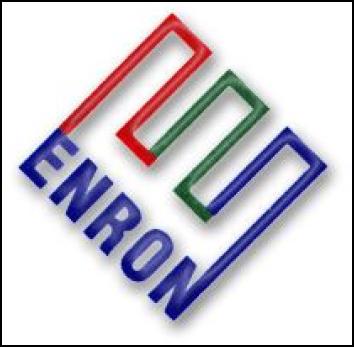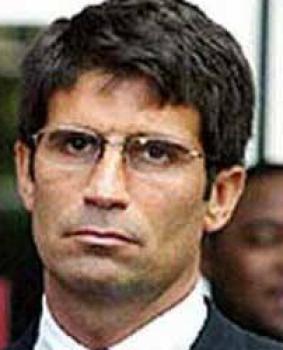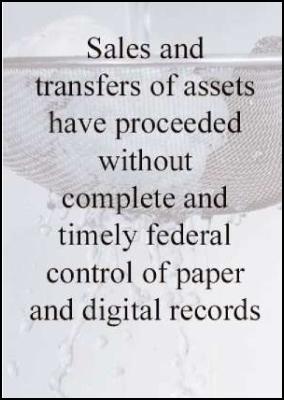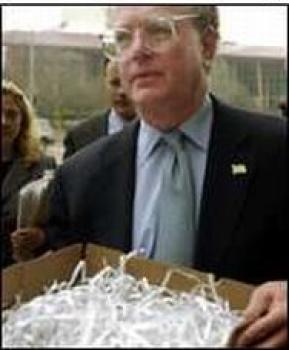The Real Deal About Enron (Part 2) – Interview
Mapping the Real Deal…
The Real Deal
About Enron
... an interview with Scoop Real Deal Columnist Catherine Austin Fitts
Part Two Of Seven Parts
By Daniel Armstrong*
Originally Published By Sanders Research Associates
[*Daniel Armstrong is a writer and novelist based
in Eugene, Oregon. Mr. Armstrong is a graduate of Princeton
University and attended the University of Oregon School of
Journalism.] (
Click Here for Part One In
Part One, we introduced the subject of this interview
Catherine Austin Fitts and described some of her experiences
in taking on the criminal powers who lie behind the modern
U.S. Governmental
apparatus. DA: In 1989 and 1990, Catherine, you
worked for HUD Secretary Jack Kemp in the first Bush
Administration. Kemp was a member of the oversight board for
the Resolution Trust Corporation (RTC) that was set up for
the S&L cleanup. Part of your responsibilities at HUD was to
provide regulatory support to Kemp and to the RTC people and
its operation, regarding mortgage and property disposition.
Also, between 1994 and 1996 you served as a board member of
First American Corporation, after former New York Banking
Commissioner Harry Albright was appointed Trustee of the
First American Resolution. You were there to assist in
selling First American financial assets and unraveling its
BCCI connections. CAF: That's correct. I was initially
brought into the Bush Administration to ensure that the
Federal Housing Administration (FHA) at HUD was sound and to
help clean up the IranContra Fraud at FHA/HUD. There were
also fraud issues related to regulatory responsibility in
the Freddie Mac, Fannie Mae, Federal Housing Loan Bank
system, and the U.S. mortgage market---that dovetailed into
the S&L work. After I left HUD, I became a board member of
Carteret Savings & Loan to help some old partners with more
S&L clean up. Since my days at Dillon, Read, I had a
reputation for successfully reengineering financial
situations that others thought were hopeless. DA:
Beginning in 1996, your company Hamilton Securities, Inc,
which was on a competitive contract with HUD as a financial
advisor, was sued by HUD contractor Ervin Associates and
then investigated by the Department of Justice for alleged
insider trading, bid rigging, fraud, and conflicts of
interests. No basis was found to support any of those
allegations by their investigators in 1996, then again in
1999, and finally a year ago, they dropped all
investigations. Those allegations against Hamilton are
similar to those filed against Enron Corporation. So not
only have you been part of the clean up of several large and
complex fraud cases, but you have also been on the receiving
end of a DOJ investigation---on allegations not terribly
different than those in the Enron case. Additionally, you
were a member of the SEC's Emerging Market Advisory
Committee from 1990 to 1993. Clearly, you must have a pretty
good sense of corporate law and first hand knowledge of what
goes on in government fraud investigations. I know from
articles you have written that you are not fully convinced
the investigation of Enron is in good faith---also that you
feel a lot of mistakes and omissions were made in the way
the DOJ initiated its investigation. Can you explain some of
this? CAF: There are seven steps that should have been
taken if the federal intelligence, investigation, regulatory
and prosecution agencies were serious about stopping the
Enron fraud, getting our money back and holding guilty
parties accountable. All seven are based on two fundamental
principles that you always see working when prosecutors and
investigators are doing a competent job. The first
fundamental principle is: Make sure you have control of all
the data and information about money and how that money is
used in the organization. The second fundamental principle
is: Make sure you use that control---of the data and
information---to gain control of any cash that was stolen or
wrongfully used. Let me emphasize at the outset that Enron's
management and board of directors and their accountants and
banks have admitted to securities violations, gross
negligence, sham transactions, and obstruction of justice.
So let's not skirt the issue: we have a self-proclaimed
criminal enterprise. I believe that Enron was also engaged
in additional financial fraud and money laundering. DA:
Michael Kopper, the first Enron employee to be arrested,
pleaded guilty to one count of conspiracy to commit wire
fraud and one moneylaundering charge in late August of this
year. [1]Is this what you mean by additional financial
fraud? CAF: This is just the
narrowest sense of what I was suggesting. I will expand upon
that as we go along. The first thing a serious
investigation, regulatory and enforcement effort does is to
establish control of both the records that document how the
money works and the cash. It helps to compare financial
fraud such as Enron participated in to a game of basketball.
The ball is the cash and you want to keep your eyes on the
ball at all times. Keeping that in mind, let's walk through
the seven steps of what a competent investigation and
prosecution effort should have done. The first step is to
get control of all the documents. By all the documents I
mean all the papers and digital records of Enron and its
3,000 subsidiaries and special purpose entities that inform
"how the money works'', both onshore and offshore. You also
make sure you get control of all the Enronrelated records
at their banks, auditors and other vendors, both onshore and
offshore. It's impossible for us to tell, from where we are,
the exact extent of the subpoena or other discovery actions
that have been taken, but clearly there's a great deal that
has not been done, particularly offshore, just based on the
public record. We know the government permitted extensive
shredding of documents by Arthur Andersen and Enron,
something that is incredibly disturbing because it proves
that months into an investigation, the SEC and DOJ chose not
to assert the initial control that was essential to the
success of any such investigation. DA: And, in your case
with Hamilton Securities, an instance where government
auditors later verified your innocence, the DOJ wasted no
time, seizing your office, your records, and your cash.
CAF: Yes. To me this is the big giveaway. The DOJ simply
did not take timely control of Enron's documents. In
Hamilton's case, DOJ and their informant were responsible
for destroying the digital infrastructure of a company whose
operations and equity value was dependent on those
databases, software tools, and documentation. They took
extreme measures to get control of all digital and paper
records---even when their own investigators had documented
there was no need. In Enron's case, the DOJ politely skipped
over all of this--- and the second step in an investigation:
you never allow the transfer of assets before you assert the
appropriate controls. And yet we've seen the government
readily permit the transfer of Enron Online to the Just one
of the little guys Union Bank of Switzerland (UBS), one of
Enron's largest creditors. So now it's very possible that a
great deal of information that would be needed for a proper
investigation is under the protection of the privacy laws of
a Swiss bank. DA: As I understand it, Citigroup and
MorganChase, who have both been mentioned in the Enron web,
were also part of the bidding process for Enron Online that
took place in January of 2002. [2] CAF: Yes, one would
expect that. Like UBS, they were major Enron creditors. But
what's interesting, and perhaps quite significant to note,
is that a recent addition to the UBS board is Lawrence
Weinbach, a former chairman of Arthur Andersen, the
accounting firm that shredded Enron documents. DA: I saw
that. Lawrence Weinbach had been the CEO at Unisys since
1997. Prior to that he spent nine years as managing partner
and chief executive for Andersen Worldwide---which includes
Arthur Andersen where Weinbach began his career in 1961.
[3]UBS announced Weinbach as Chairman of their Audit
Committee Board on February 22 of 2002. [4]UBS bought
Enron's North American wholesale electricity and natural gas
trading business on January 18, 2002. [5]The timing is
certainly curious. CAF: Enron was also permitted to sell
and transfer its gold bullion and gold derivatives trading
operation. Understand that to be able make these two sales
and transfers of Enron Online and the gold operations, as
quickly and quietly as they were, in the middle of an
initial bankruptcy filing, was nothing short of miraculous
based on what I'm told by bankruptcy attorneys. In
combination with the illegal shredding, it would have
permitted the coordination of the cover-up of possible money
laundering or financial fraud between the banks and Enron
Online. These sorts of things will be easier to keep hidden
because one of the creditors and trading partner banks now
controls what is probably the most likely guilty entity.
Thus the ability of any prosecutor to play the banks and the
target off against each other in the discovery and
investigation process is diluted or lost. DA: So the
government allowed the transfer of assets in a way that may
prevent access to the documents and personnel necessary for
a successful investigation and recapture of stolen monies.
Does this also mean that the bank records can be coordinated
with Enron Online discovery behind the protection of
attorney client privilege? CAF: It would appear
that way. Sales and transfers of assets have proceeded
without complete and timely federal control of paper and
digital records, including computers and all data storage
devices. Unlike Enron, Hamilton did not shred documents and
provided redundant copies of records and back up computer
tapes to counsel who provided assurances to the federal
government that no originals would be destroyed. The
documents sequestered by Hamilton included records of all
subsidiary entities. DA: In these first two steps,
controlling records and assets, above and beyond collecting
Arthur Andersen's documentation, communication with Enron's
banks surely must be a critical part of this initial
process. We've already mentioned MorganChase and Citigroup
as Enron creditors. But there is a specific accusation that
senior credit officers at Citigroup manipulated records to
hide a $125 million Enron debt to Citigroup.[6] From what
I've read, it's unclear if the federal investigators will
fully pursue this. But don't the banks have to be largely
involved? Compliant, perhaps complicit, to the point of
assisting? CAF: Indeed, both Citigroup and J.P.
MorganChase, Enron's two lead banks, were called to task
and to testify before the permanent subcommittee on
investigations of senate government affairs committee on
July 23rd . Both banks had been verified as complicit in
creating "special purpose entities'' (SPEs) to round trip
transactions as a way to loan money to Enron without calling
it a loan. In the course of this maneuver, Enron and its
trading as well as lending partner, MorganChase, created
the façade of a business/trading activity as opposed to a
borrowing activity thereby falsely boosting their revenues.
While both banks denied this, the testimony and documents
provided to the Senate, clearly support the Senate's
position---making this even more egregious and suggesting
the banks themselves created and controlled the SPEs. DA:
On September 13th a federal judge dismissed MorganChase
fraud claims against its insurers, perhaps, preventing the
bank from collecting $935 million in loses on gas and oil
trades with Enron. [7] Then in its own defense, MorganChase
attorneys argued, incredibly, that the insurers knew the
deals were shams intended to hide loans to Enron. What does
all this doubletalk by MorganChase mean? CAF: That we
need to know if Enron or, at least, Enron Online was
essentially a SPE for New York Fed member fraud and money
laundering. This brings us to a question critical in getting
to what was really going on at Enron---the part outside
investors played in the Enron game. We can get to that from
the third step of our investigation. You always get document
and cash control, if you can, before a bankruptcy filing.
DA: Enron filed for bankruptcy protection on December
2nd. [8] CAF: Yes, Enron filed for bankruptcy before the
feds asserted control, and well after numerous members of
the Bush Administration were informed that Enron was
teetering on the verge of collapse, and after what appears
to be many efforts by the administration to help them keep
going, and long after SEC investigations had begun. When
Enron filed for bankruptcy, its own board worked over a
fourmonth period to "investigate what went wrong.'' This
was only possible because of DOJ complicity at the time. And
this is important. A bankruptcy filing gives Enron
additional powers and rights to protect themselves,
particularly from the class action lawsuits that, on a
private basis, could dig out some of the data about how the
money worked and those bank relationships you brought
up---even if the DOJ and SEC don't succeed in digging this
out or are, in fact, covering it up. DA: What you're
saying is, yes, an investigation is going on, but as
congressional investigators slowly stumble through the
testimony---it's been a year now, they have given Enron a
chance to work over or obliterate the evidence. And you feel
this is deliberate? CAF: It looks that way. Enron's
bankruptcy filing created a stay against all suits against
Enron. Those directed at board members and management could
proceed. Hence private discovery of Enron's records may be
limited. Watching this process, my question is did the DOJ
specifically help Enron get into bankruptcy, and define
their investigations, so as to protect the information from
class action investigation? ENDNOTES: In Part Three the interview continues.
©opyright Daniel Armstrong, March
2003 If my years working
on the clean up of BCCI and the S&L crisis taught me one
thing that I would communicate today to the shareholders,
retirees and employees who have been harmed, it is this:
people like those on the board of Enron absolutely make
money from insider trading, bid rigging and fraud, and they
do so with help from the highest levels.
-- Catherine Austin Fitts. 
IMAGE: Enron
- Click Through To Original
Article
http://www.scoop.co.nz/mason/stories/HL0304/S00031.htm
)
INTERVIEW TRANSCRIPT
BEGINS

IMAGE: One Of The
Little Guys

IMAGE: What's In The
Box?
1
http://www.msnbc.com/news/796841.asp?cp1=1
2 http://www.chron.com/cs/CDA/story.hts/special/enron/dec01/1180417
3 http://www.ubs.com/e/index/about/our_organization/
executivebodies/boardofdirectors/lawrence_a_weinbach.html
4 http://www.ubs.com/e/index/media/media_global/mediareleases/20020222a.layer.e.html
5 http://www.ubs.com/e/index/media/media_global/mediareleases/20020118a.layer.e.html
6 http://securities.stanford.edu/1025/C0201/
7 http://www.forbes.com/2002/03/06/0306topnews.html
8 http://money.cnn.com/2001/12/02/companies/enron_filing/
Catherine Austin Fitts is the President of Solari, Inc. ( http://solari.com) and a former
Assistant Secretary of Housing – Federal Housing
Commissioner in Bush I. She is currently litigating with
Ervin and Associates (acting on behalf of the government )
and the Department of Housing and Urban Development. If you
would like to support her litigation efforts, you can
through Affero/ Venture Collective:
http://www.solari.com/vote.php
If this “Mapping the
Real Deal” was useful for you, you can leave comments and
send a gift to Catherine Austin Fitts and Scoop Media
through Affer:
http://svcs.affero.net/rm.php?skid=sp0
and receive
future columns for free by e-mail - see... Free My Scoop to sign up. ![]()


 Binoy Kampmark: Detained Without Charge - Eleven Yemenis Leave Guantánamo
Binoy Kampmark: Detained Without Charge - Eleven Yemenis Leave Guantánamo Ramzy Baroud: The War Criminal 'Victim' - Netanyahu’s Inevitable Fate
Ramzy Baroud: The War Criminal 'Victim' - Netanyahu’s Inevitable Fate Martin LeFevre - Meditations: From Symbolic Consciousness To Insight Consciousness
Martin LeFevre - Meditations: From Symbolic Consciousness To Insight Consciousness Binoy Kampmark: Arresting And Killing Greenies - Targeting Climate Change Protests
Binoy Kampmark: Arresting And Killing Greenies - Targeting Climate Change Protests Ian Powell: Welcome Puberty Blockers Report But Beware Derailing Transphobia
Ian Powell: Welcome Puberty Blockers Report But Beware Derailing Transphobia Gordon Campbell: On Why We Can’t Survive Two More Years Of This
Gordon Campbell: On Why We Can’t Survive Two More Years Of This